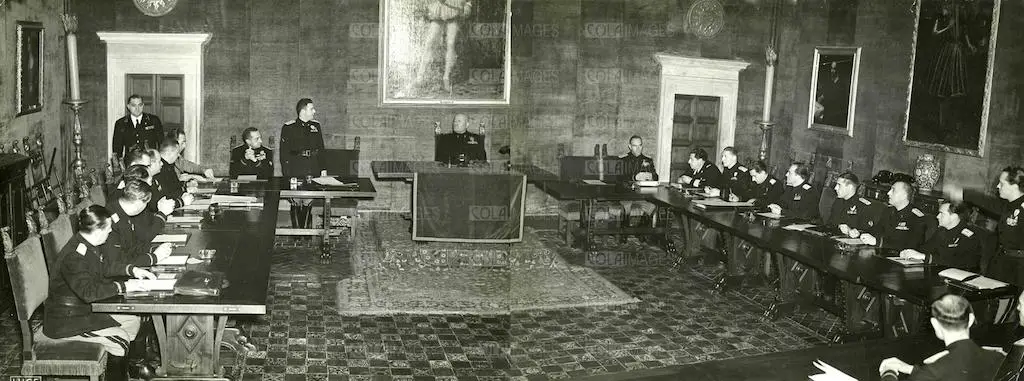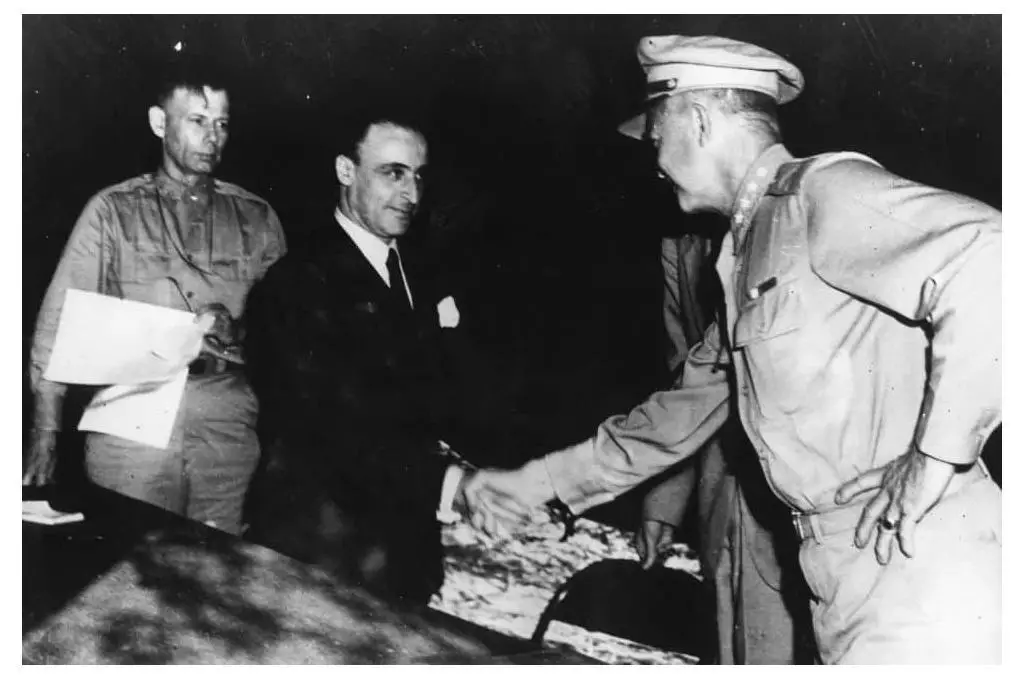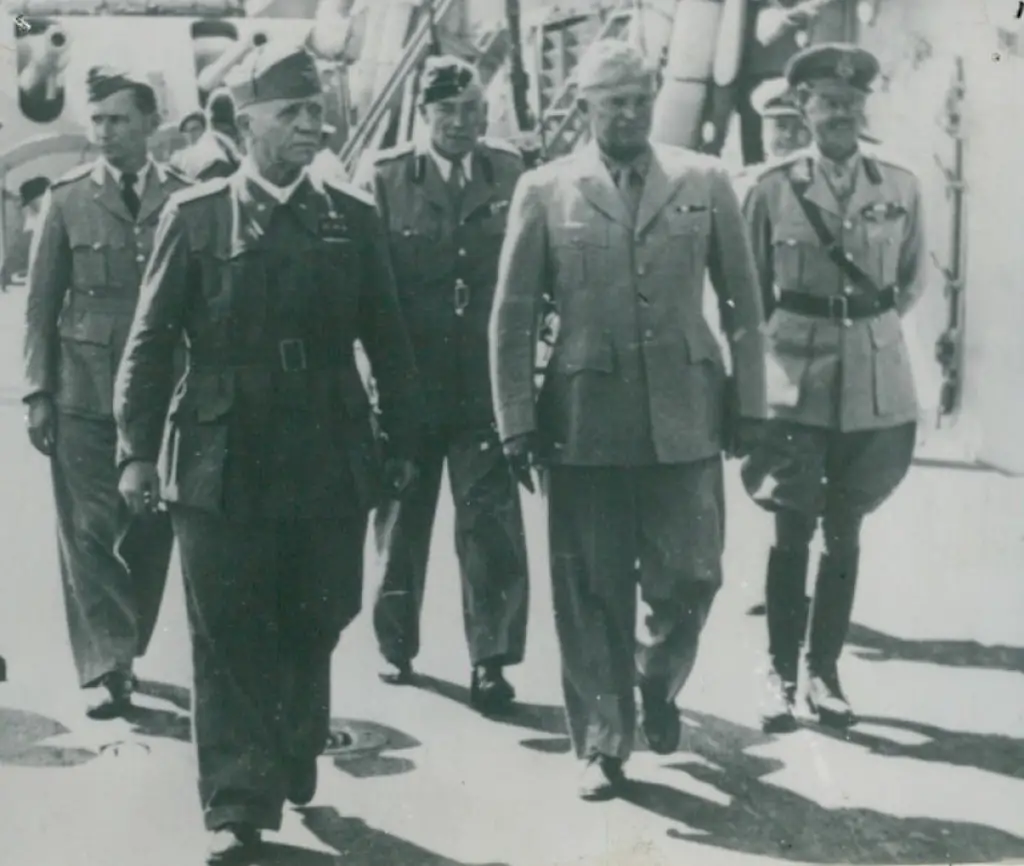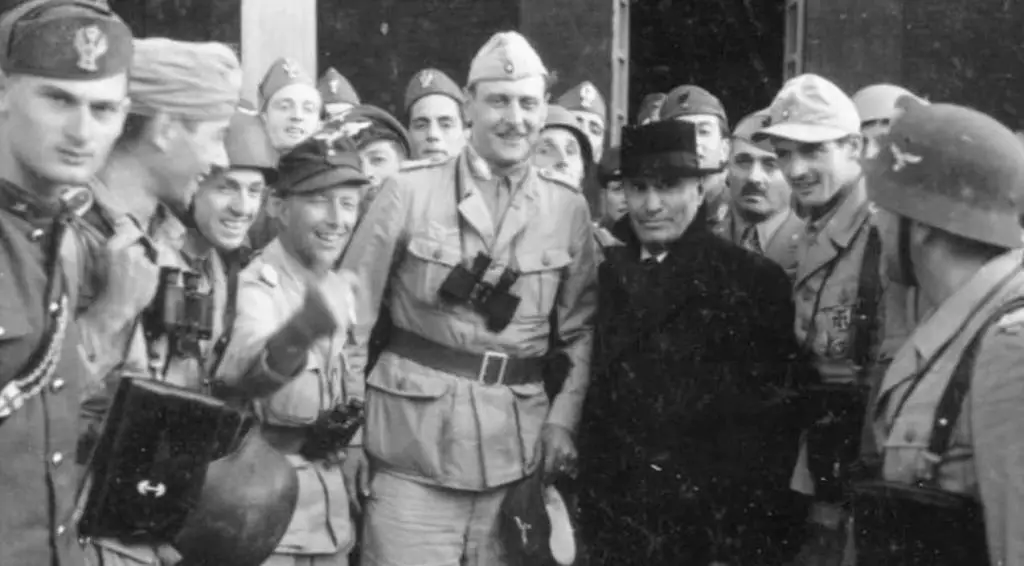January 1943
Operation Weiss (White) commences. A joint Italo-German campaign to eliminate Yugoslavian partisans.
January 2 – British frogmen sink the Italian cruiser Ulpio Traiano in Palermo with explosive charges.
January 7 – U.S. bombers sink Italian destroyer Bersaglieri in Palermo.

Possible replacements for Mussolini include Cavallero, Badoglio, Grandi, Bottai and Farinacci.
January 8 – Galeazzo Ciano meets with Giuseppe Bottai and Roberto Farinacci about possible replacements for Mussolini. Some names mentioned include Field Marshal Ugo Cavallero, Field Marshal Pietro Badoglio, Dino Grandi, and Bottai and Farinacci themselves. Although Mussolini’s gastric problems were growing ever more serious, he kept abreast of possible overthrows of his government through informers and the OVRA, who notified him at his retreat in La Rocca della Caminate. He decides to clear out most of the members of his government with new loyalists.
January 9 – Italian destroyer Corsaro hits a mine and sinks off the coast of Tunisia.
January 10 – The Arditi Regiment, in teams of 9 to 10 men, parachute in various places in Libya, Tunisia, and Algeria for covert warfare duties. Although not as successful as they had hoped to be, they managed to destroy or damage the bridges in Bonira, Beni Mansour, and Uadi Bouduvaou.
January 12 – Destroyer Grecale rams and sinks Italian Torpedo Boat Ardente.
January 17 –British submarine HMS United sinks Italian destroyer Bombardiere off the coast of Sicily.
January 31 – Mussolini replaces armed forces Chief of Staff, Field Marshal Ugo Cavallero, with General Vittorio Ambrosio.
Italian Torpedo Boat Marcello Prestinari sinks after hitting a mine.
February 1943
February 3 – Italian destroyer Saetta and Torpedo Boat Uragano sink off the coast of Tunisia after hitting a minefield.
February 5 – Mussolini fires Galeazzo Ciano as Foreign Minister.
March 1943
The consequences of Ultra begin pitting the Germans against the Italians. The British receive advance warning of the actions in Medenine through the deciphering of Enigma. They then begin to spread the word that they learned of these plans from senior Italian officials. The same applied to Alam el Halfa battle in August 1942. Tension begins to mount between the Germans and Italians, who deny the allegations.
Considerable losses inflicted on the British 56th Division by Italian forces in Mareth.
March 1 – U.S. bombers sink Italian destroyer Geniere in Palermo. U.S. bombers sink Italian Torpedo Boat Monsone near Naples.
March 5 – Fiat Aeronautics plant in Turin goes on strike. This is the first strike since Mussolini enters the office in 1922. Mussolini calls on his Fascists troops to stop the strike, but they refuse to make the workers stop protesting. Other strikes erupt, grounding Italy’s war-making capabilities.
March 8 – Italian Torpedo Boat Ciclone sinks off the coast of Tunisia after hitting a mine.
March 24 – Italian destroyers Lanzerotto Malocello and Ascari sink off the coast of Tunisia after hitting a minefield.
April 1943
April 1 – Italian destroyer Lubiana (Former Yugoslav destroyer Ljubljana) is scuttled after it runs aground off Tunisia.
April 6 – Mussolini meets with Hitler in Austria. Mussolini requests that Germany and Italy attempt to make peace with Russia in order to concentrate on the weakening Axis forces in Africa. Il Duce fears the Allies will invade Italy if Africa falls. Hitler dismisses the idea of peace with Russia and assures Mussolini of a victory in the conquest of the Soviet Union. Mussolini returns to Rome with renewed hope. General Ambrosio assigns his top aides to come up with a plan to oust Mussolini.
April 10 – U.S. bombers sink Italian cruiser Trieste near La Maddalena.
April 16 – British destroyer HMS Pakenham and Italian Torpedo Boat Cigno sink after a convoy battle off the coast of Sicily.
April 19 – U.S. bombers sink Italian destroyer Alpinoin La Spezia.
April 20-21 – Folgore Parachute division, dwindled to 200 men, succeeds in conquering the Takrouna stronghold whose village on a hill was deemed impracticable to climb. There, the Folgore defends it to the end until they are finally annihilated by superior allied forces.
April 28 – Italian Torpedo Boat Sagittario sinks British MTB 639 off the coast of Sicily.
British submarine HMS Unshaken sinks Italian Torpedo Boat Climene off the coast of Sicily.
April 29 – Considerable losses inflicted on the British 56th Division by Italian forces in Enfidaville.
April 30 – U.S. bombers sink Italian destroyers Lampo and Leone Pancaldo off the coast of Tunisia.
May 1943
May 4– British destroyers sink Italian Torpedo Boat Perseo off the coast of Tunisia.
May 7 – Italian Torpedo Boat Tifone is scuttled in Tunisia prior to Allied forces approaching the harbor.
May 8 – Tunisia falls to the Allies.
May 12 – German General Von Arnim is captured.
May 13 – 275,000 Italian and German forces surrender to Allied troops on the Cape Bon peninsula. Field Marshal Messe is captured.

German and Italian prisoners after the fall of Tunis in 1943.
May 25 – U.S. bombers sink Italian Torpedo Boat Groppo in Messina.
May 28 – U.S. bombers sink Italian Torpedo Boats Anatares and Angelo Bassini in Livorno.
June 1943
June 2 – British destroyers sink Italian Torpedo Boat Castore off the coast of Greece.
June 12 – Allied invasion force enters the Island of Pantelleria and Lampedusa, encountering 12,000 Italian soldiers who surrender immediately. This invasion makes the Fascist government of Italy certain of an eventual invasion of Italy.
Franco Cargnel and Vito Procida parachute near Benghazi and covertly reach the Benina North Airport, there they put explosive charges in 20 allied aircraft, destroying them all.
June 28 – U.S bombers sink Italian cruiser Bari at Livorno.
July 1943
July 9-10 – Allied paratroopers parachute onto Sicily followed by a mass invasion by landing crafts. The Allies face sporadic engagements from the demoralized Italian soldiers.
July 16 – Mussolini and 15 of his cabinet members meet. The discussion turns to the possibility of Mussolini relieving himself of some of his authority and assign responsibilities to others in order to make the government more efficient. Mussolini agrees to bring this matter to attention at the next Grand Council meeting.
July 17 – Italian cruiser Scipione Africano sinks British MTB 316 off Messina.
July 19 – Mussolini again meets with Hitler in the Northern Italian town of Feltre. By now, Mussolini was very influenced by the stronger Hitler, and it was much to his discontent that this was the case. Members of Mussolini’s party urged him to speak to Hitler about a possible way for Italy to exit the war, but Mussolini only asks for more military assistance. Hitler agrees, only if it is run under German authority. The tide had finally turned, Italy was now under the control of the German forces. Romans are shocked at the first of a series of Allied bombings of the Eternal City. Pope Pius XII, robe covered in blood, gives Last Rites to many of the dying Italians in the streets. The death toll eventually reaches 1,400 and 6,000 injured.
July 21 – Mussolini learns of Dino Grandi’s plan to oust him and restore total authority back to the Grand Council.

The Grand Council meets in 1943.
July 24 – Grand Council convenes. Grandi, with a hand grenade hidden by his thigh for possible suicide rather than an arrest, is criticized by Mussolini for wanting to strip him of his powers. Mussolini agrees on a roll call vote in which a majority was not achieved to oust him.
July 25 – Mussolini meets with King Victor Emanuele. The King expresses to Mussolini that Italy no longer wants war and that he is the most hated man in Italy. Caught off guard, Mussolini responds with an offer of resignation which is accepted. The King then offers Mussolini an armed escort which he accepts. Mussolini did not know that this was actually an arrest. Italy proclaims Pietro Badoglio as the new Prime Minister.
After news of Mussolini’s arrest, many fellow Fascist leaders flee Rome. Italians and Germans alike remain silent as the new Badoglio government proclaims that the war will continue. Even with this proclamation, many Italians begin to cheer the ousting of Mussolini. Hundreds of people are ordered shot as Badoglio’s government attempts to gain order.
Badoglio soon begins to try and find a way out of the war without Germany knowing. He begins secretive talks with the Allies in the Vatican. General Guiseppe Castellano secretly meets with Allies in Spain and Portugal. The new Italian government offers to assist in the war against Germany, but need Allied reinforcements in Rome before the declaration of war against Germany is delivered. The Allies feel uncomfortable with this offer because the nature of war calls for an unconditional surrender of the enemy before any real negotiations could be accomplished. To show Italy’s good faith, Castellano offers the Allies the German troop placements in Italy along with the strengths and weaknesses of key areas.

General Giuseppe Castellano, in civilian attire, shakes hands with General Eisenhower after signing the armistice.
After many trips to and from Portugal, the Allies offer Italy a 2-part surrender agreement known as the Short Terms and the Long Terms. These Terms included the cessation of hostilities, returning of allied prisoners, the surrender of the military arsenal, and the establishment of an allied military government.
July 26 – Mussolini was no longer in power and it became obvious that a confrontation with Germany was imminent. Tancredi Galimberti, a member of the underground Action Party, shouted from a balcony in Cuneo, “The war goes on, but against Germany. For this war, there is one means – popular insurrection.” The crowd stood silent. No one had the will to fight anymore. They had hoped that Italy would just be left alone, but they knew that would not happen. Nobody took Galimberti’s call for arms, and it wasn’t until Germany began treating Italy as an occupied nation and a subservient people, did they rise up against the Germans.
One such instance was when 16 Italians were killed in the village of Rionero Sannitico, because an old Italian farmer wounded a German soldier trying to steal a chicken.
August 1943
August 5 – U.S. bombers sink Italian Torpedo Boat Pallade in Naples.
August 8 – U.S. bombers sink Italian destroyer Freccia in Genova.
August 9 –British submarine HMS Simoon sinks Italian destroyer Vincenzo Gioberti off La Spezia.
August 17 – Axis resistance in Sicily ends.
August 28 – British submarine HMS Ultor sinks Italian Torpedo Boat Lince in Taranto.
August 31 – Allies offer to give Italy 48 hours to officially surrender and then they would drop a U.S. Airborne division near Rome to help defend against the Germans. Italy wants more time to prepare to fight the Germans, but the Allies refuse the wait.
September 1943
September 3 – General Montgomery lands 2 Divisions near Reggio di Calabria. Prime Minister Badoglio radios Castellano the authorization to surrender.
September 8 – Badoglio sends a code to General Eisenhower repudiating the surrender terms. The Italian government was beginning to feel shaky of letting Allies freely into Rome. The Long Terms seemed to be made by the victor for the defeated and Italy was still capable of fighting for the Allies. Eisenhower, upset over the lack of progress in the surrender talks, broadcasts Italy’s surrender over the radio at 6:30 PM.
Italy was now placed in a tough situation, to either confirm the surrender or face warring both the Allies and Germany. At 7:45, Badoglio informs his country of the Italian surrender. Italians cheer and the Germans become infuriated.
September 9 – Allies come ashore at Taranto and Salerno.
Badoglio orders his military to stop any hostilities and the Germans begin to disarm the Esercito. Germans shoot Italian officers who protest their disarmament. Germans take over 615,000 Italians soldiers prisoner. Only 1% offer to join the Germans.

On the deck of the battleship Nelson to sign the final armistice agreement. (L-R) Governor of Malta Lord Gort, Air Chief Marshal Arthur Tedder, Marshal Pietro Badoglio, Lt General Noel Mason-MacFarlane, General Dwight Eisenhower, Commodore Royer Dick (face only) and General Harold Alexander. Photos: National War Museum Association
The Italian fleet sails to Malta as part of the Short Terms, and to prevent them from getting into German hands. The Italian Battleship Roma is the only casualty; sunk by a German guided bomb.
Cruiser Taranto, Destroyers Maestrale, Corazziere, Nicole Zeno, and FR 21 (Former French destroyer Lion) and Torpedo Boats Antonio Cascino and Procione are scuttled in various ports to prevent German capture.
Italian destroyer Antonio Da Noli hits a mine off Corsica and sinks.
King Victor Emmanuelle and Prime Minister Badoglio flee Rome and set up a Government in Brindisi. The Italian Armed Forces become confused and leaderless. They do not know whether to fight the Germans or not.
German troops try to occupy Bari harbor. General Nicola Bellomo, commander of the XII MVSN Zone, forms a group of Italian forces and counter-attacks the German position, with himself personally leading the action. Bellomo joins men of 151st Militia Legion, 9th Engineer Regiment, and some sailors, Guardia di Finanza, and carabinieri. Approximately 100 men, with a few weapons, comprise this emergency Italian force. Italians oust the Germans from Bari following two hours of fighting. In this engagement, General Bellomo sustains multiple wounds.
September 11 – Italian Torpedo Boat T6 (Former Yugoslav Torpedo Boat T6) is scuttled off Cesenatico. A German bomber sinks Italian Torpedo Boat T8 (Former Yugoslav Torpedo Boat T8) in Punta Oliva.
Torpedo Boats Giuseppe La Masa and Partenope are scuttled in the port of Naples when German forces approach the harbor.
Torpedo Boats Impetuoso and Pegaso are scuttled in Mallorca.
A German S-Boote sinks Italian destroyer Quintino Sella in the Adriatic.
September 12 – From July 27 to September 12, the Italian Military Intelligence (SIM) and German Intelligence Agents play cat and mouse in the German attempt to locate Mussolini. On September 12, Lt. Otto Skorzeny pilots a glider to Gran Sasso and rescues Mussolini. Mussolini flies to Hitlers Headquarters in Rastenburg.

Benito Mussolini standing with German rescuers.
September 23 – Mussolini flies back to Northern Italy to his resort at La Rocca delle Caminate and proclaims himself Head of State of the new Italian Republic, with the capital as Salò. This “new” nation shall be known as the Salò Republic (Italian Social Republic or RSI). Mussolini continues to promote his Fascist ideals and how the Italian people let him down. Mussolini orders a revival of his military with a new uniformed military including the Republic National Guard, police, and 10th Squadron naval commandos.
September 25 – Italian Torpedo Boats Francesco Stocco, Enrico Cosenz, and Giuseppe Sirtori are scuttled in Corfu, Greece when German troops invade the island.
October 1943
October 1 – German bombers sink Italian Destroyer Euro by Leros.
By October, Naples was especially active in Partisan uprisings. Thousands of insurgents volunteered. Germans abandon Naples following civil uprising and the approaching Allies. There was a heavy price to pay for this victory. The Germans systematically looted the city and placed timed bombs throughout public areas.
October 13 – King Victor Emanuele declares war on Germany. Italy, at this point, had little to offer militarily, but what Italy lacked in military armament, she made up in hatred for the Germans and the Fascist/Nazi ideology. Germany has 22 divisions and Mussolini has six RSI divisions that liberated Italy and the partisans must fight.
Committees for national liberation sprang up in the North to fight both the Germans and the new Salo Republic. In Southern Italy, it was less organized but just as effective. Bands of Partisans sprang up and commenced attacking German units.
October 16 – Gestapo enters Rome and arrest 1,000 Jews. Pope Pius XII offers asylum to 4,700 Jews in the monasteries and convents in Rome.
November 1943
December 1943
December – The liberated Italian army was fighting alongside their new allies against the Germans. Italian participated in the battles of Monte Lungo, Monte Cassino, and the liberation of Rome. Italian partisans also managed to sidetrack over 200,000 Germans due to their resistance.
December 20 – A partisan exploit dismembered a train carrying ammunition to Monte Cassino, killing 500 German troops. There are reports of more than 2,200 partisan actions by the end of 1943.
